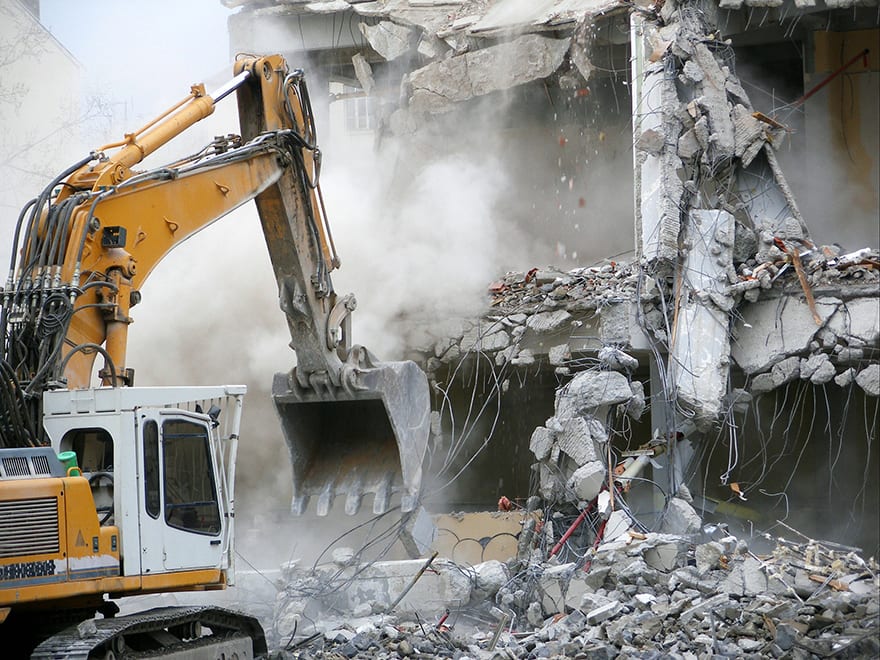
Where there is good as-built information it is likely to be possible to digitally transfer this to a BIM/DIM system which can then offer robust data for deconstruction purposes.– Michael Ulyatt
Ahead of a conference at Nottingham Trent University in April, Michael Ulyatt MCIOB, a member of the Institute of Demolition Engineers, says it’s time to extend BIM beyond a building’s operational lifespan.
As the construction sector embraces the BIM debate, attention is now shifting towards a call from the Institute of Demolition Engineers (IDE), the demolition sector’s professional body, that the time is right to extend BIM into DIM – Deconstruction Information Modelling.
Considering applying BIM to deconstruction is not new, but the focus has always been on the conceptual side, rather than on any steps to practical application. Academic papers going back almost 10 years have touched on what many now see as an obvious development of BIM, into demolition and deconstruction. But as yet, there has been no substantive practical application.
Specifically, the lack of formal guidance on DIM is an obvious gap in the current suite of BIM guidance documents and protocols, a gap that has arisen due to the construction sector’s lack of engagement with the demolition sector, but a gap that will hopefully be addressed soon.
There are two distinct strands to the development of DIM. The first is in relation to new build projects that have already benefited, or will benefit, from BIM. The data array captured at the design stage will provide the starting point for deconstruction, which, for the sake of risk management and truly sustainable construction, ought to form an integral part of design thinking for every project going forward.
It will be necessary to review the data requirements for BIM/DIM, since this will not simply be an extension of current BIM functionalities due to the fundamentally different requirements of deconstruction. It’s important to understand how buildings react during deconstruction and the very real possibility that each step could effectively weaken the structure.
Information relating to the construction and durability of components will inform the recycling, reuse or disposal options and provide information on any hazardous materials, which may inform deconstruction methodology and will definitely guide H&S planning and materials disposal. This might involve DIM information for products and components being embedded in the digital BIM object data from design stage, or a requirement for augmentation of as-built BIM models with DIM information.
Engaging with the deconstruction sector will enable development of a rational and practical set of properties for recording, analysing and using DIM. Given the sector’s experience in handling materials others class as waste, engagement during the planning and design stages would, in all probability, lead to identification of re-use and reclamation opportunities which could influence the final design choice.

It’s important to understand how buildings react during deconstruction
But aside from adding DIM to BIM information for new-build projects, the most interesting challenge rests in developing DIM for existing structures. Where there is good as-built information it is likely to be possible to digitally transfer this to a BIM/DIM system which can then offer robust data for deconstruction purposes. Where there is poor or incomplete as-built information, or original design information that may, or may not, reflect the final as-built condition, the challenge rests in data abstraction.
Non-destructive inspection and testing approaches which currently exist are, to varying degrees, already in use in construction. These would include electro-magnetic waves, ground penetrating radar, laser scanning, magnetic particle inspection, photogrammetry, radiography and sonar.
All of the above could find an application in data abstraction for DIM on existing buildings. These techniques are at the leading edge of engineering and design but data capturing applications have a role to play in the future and will determine a component’s propensity for extraction and re-use.
The health and safety advantages of DIM could be very significant, for instance in reducing operatives’ exposure to risks and hazards such as asbestos or any of the other products that, upon deconstruction, are potentially injurious to health.
Of course, creating a DIM model of an existing building could potentially incur a substantial up-front cost, and any development would be unlikely to realise any financial benefits on a pilot project. But if it became standard practice, after several iterations it is likely there would be cost savings, as well as health and safety benefits, to the broad sector using such an approach.
The UK is best placed to lead this important area of development. The UK is home to the only professional demolition institute in the world, the IDE. Its expert demolition engineers lead the world in demolition professionalism and are poised to lead on DIM deliberations in conjunction with BIM concepts. Now is the time for mainstream construction institutes, the design fraternity and the manufacturers of construction products to come together with the IDE and turn DIM from concept into practical application.















